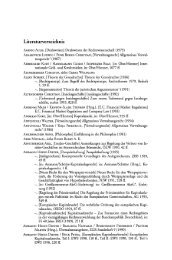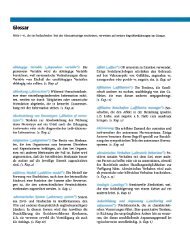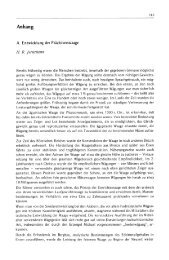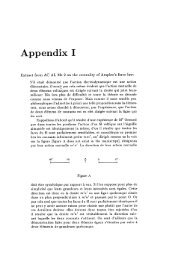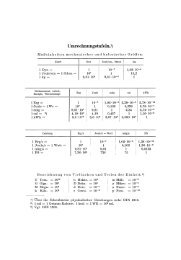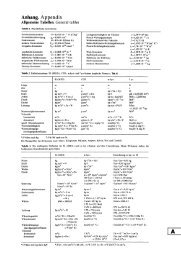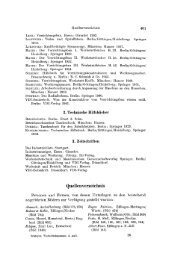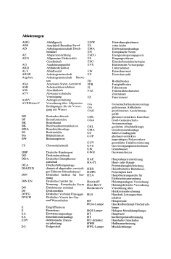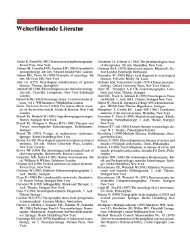Download PDF - Springer
Download PDF - Springer
Download PDF - Springer
Create successful ePaper yourself
Turn your PDF publications into a flip-book with our unique Google optimized e-Paper software.
Environ Health Prev Med (2013) 18:185–197 19566. Bird A. DNA methylation patterns and epigenetic memory.Genes Dev. 2002;16:6–21.67. Drake AJ, Walker BR, Seckl JR. Intergenerational consequencesof fetal programming by in utero exposure to glucocorticoids inrats. Am J Physiol Regul Integr Comp Physiol. 2005;288:R34–8.68. Burdge GC, Slater-Jefferies J, Torrens C, Phillips ES, HansonMA, Lillycrop KA. Dietary protein restriction of pregnant rats inthe F0 generation induces altered methylation of hepatic genepromoters in the adult male offspring in the F1 and F2 generations.Br J Nutr. 2007;97:435–9.69. Burdge GC, Lillycrop KA. Nutrition, epigenetics, and developmentalplasticity: implications for understanding human disease.Annu Rev Nutr. 2010;30:315–39.70. Ooki S. Life course genetic epidemiologic study based on longitudinaltwin-family data: a new perspective (in Japanese).Nihon Eiseigaku Zasshi. 2011;66:31–8.71. Drong AW, Lindgren CM, McCarthy MI. The genetic andepigenetic basis of type 2 diabetes and obesity. Clin PharmacolTher. 2012;92:707–15.72. Waterland RA, Jirtle RL. Early nutrition, epigenetic changes attransposons and imprinted genes, and enhanced susceptibility toadult chronic diseases. Nutrition. 2004;20:63–8.73. Godfrey KM, Lillycrop KA, Burdge GC, Gluckman PD, HansonMA. Epigenetic mechanisms and the mismatch concept of thedevelopmental origins of health and disease. Pediatr Res.2007;61:5R–10R.74. Dolinoy DC, Huang D, Jirtle RL. Maternal nutrient supplementationcounteracts bisphenol A-induced DNA hypomethylationin early development. Proc Natl Acad Sci USA.2007;104:13056–61.75. Ling C, Groop L. Epigenetics: a molecular link between environmentalfactors and type 2 diabetes. Diabetes. 2009;58:2718–25.76. Heindel JJ, vom Saal FS. Role of nutrition and environmentalendocrine disrupting chemicals during the perinatal period onthe aetiology of obesity. Mol Cell Endocrinol. 2009;304:90–6.77. Lillycrop KA, Phillips ES, Jackson AA, Hanson MA, BurdgeGC. Dietary protein restriction of pregnant rats induces and folicacid supplementation prevents epigenetic modification ofhepatic gene expression in the offspring. J Nutr. 2005;135:1382–6.78. Bogdarina I, Welham S, King PJ, Burns SP, Clark AJ. Epigeneticmodification of the renin-angiotensin system in the fetalprogramming of hypertension. Circ Res. 2007;100:520–6.79. Park JH, Stoffers DA, Nicholls RD, Simmons RA. Developmentof type 2 diabetes following intrauterine growth retardation inrats is associated with progressive epigenetic silencing Pdx 1.J Clin Invest. 2008;118:2316–24.80. Waterland RA, Jirtle RL. Transposable elements: targets forearly nutritional effects on epigenetic gene regulation. Mol CellBiol. 2003;23:5293–300.81. Sinclair KD, Allegrucci C, Singh R, Gardner DS, Sebastian S,Bispham J, et al. DNA methylation, insulin resistance, and bloodpressure in offspring determined by maternal periconceptional Bvitamin and methionine status. Proc Natl Acad Sci USA.2007;104:19351–6.82. Lillycrop KA, Phillips ES, Torrens C, Hanson MA, Jackson AA,Burdge GC. Feeding pregnant rats a protein-restricted diet persistentlyalters the methylation of specific cytosines in thehepatic PPAR alpha promoter of the offspring. Br J Nutr.2008;100:278–82.83. Burdge GC, Lillycrop KA, Jackson AA, Gluckman PD, HansonMA. The nature of the growth pattern and of the metabolicresponse to fasting in the rat are dependent upon the dietaryprotein and folic acid intakes of their pregnant dams and postweaningfat consumption. Br J Nutr. 2008;99:540–9.84. Heijmans BT, Tobi EW, Stein AD, Putter H, Blauw GJ, SusserES, et al. Persistent epigenetic differences associated with prenatalexposure to famine in humans. Proc Natl Acad Sci USA.2008;105:17046–9.85. Tobi EW, Lumey LH, Talens RP, Kremer D, Putter H, SteinAD, et al. DNA methylation differences after exposure to prenatalfamine are common and timing- and sex-specific. HumMol Genet. 2009;18:4046–53.86. Baillie-Hamilton PF. Chemical toxins: a hypothesis to explainthe global obesity epidemic. J Altern Complement Med.2002;8:185–92.87. Heindel JJ. Endocrine disruptors and the obesity epidemic.Toxicol Sci. 2003;76:247–9.88. Diamanti-Kandarakis E, Bourguignon JP, Giudice LC, HauserR, Prins GS, Soto AM, et al. Endocrine-disrupting chemicals: anEndocrine Society scientific statement. Endocr Rev.2009;30:293–342.89. Calafat AM, Ye X, Wong LY, Reidy JA, Needham LL. Exposureof the U.S. population to bisphenol A and 4-tertiaryoctylphenol:2003–2004. Environ Health Perspect. 2008;116:39–44.90. Vandenberg LN, Hauser R, Marcus M, Olea N, Welshons WV.Human exposure to bisphenol A. Reprod Toxicol. 2007;24:139–77.91. Mullerova D, Kopecky J. White adipose tissue: storage andeffector site for environmental pollutants. Physiol Res. 2007;56:375–81.92. Toschke AM, Koletzko B, Slikker W Jr, Hermann M, von KriesR. Childhood obesity is associated with maternal smoking inpregnancy. Eur J Pediatr. 2002;161:445–8.93. Power C, Jefferis BJ. Fetal environment and subsequent obesity:a study of maternal smoking. Int J Epidemiol. 2002;31:413–9.94. Al Mamun A, Lawlor DA, Alati R, O’Callaghan MJ, WilliamsGM, Najman JM. Does maternal smoking during pregnancyhave a direct effect on future offspring obesity? Evidence from aprospective birth cohort study. Am J Epidemiol. 2006;164:317–25.95. Wang SL, Tsai PC, Yang CY, Leon Guo Y. Increased risk ofdiabetes and polychlorinated biphenyls and dioxins: a 24-yearfollow-up study of the Yucheng cohort. Diabetes Care.2008;31:1574–9.96. Park JS, Bergman A, Linderholm L, Athanasiadou M, Kocan A,Petrik J, et al. Placental transfer of polychlorinated biphenyls,their hydroxylated metabolites and pentachlorophenol in pregnantwomen from eastern Slovakia. Chemosphere.2008;70:1676–84.97. Smink A, Ribas-Fito N, Garcia R, Torrent M, Mendez MA,Grimalt JO, et al. Exposure to hexachlorobenzene during pregnancyincreases the risk of overweight in children aged 6 years.Acta Paediatr. 2008;97:1465–9.98. Karmaus W, Osuch JR, Eneli I, Mudd LM, Zhang J, Mikucki D,et al. Maternal level of dichlorodiphenyl-dichloroethylene(DDE) may increase weight and body mass index in adultfemale offspring. Occup Environ Med. 2009;66:143–9.99. Janesick A, Blumberg B. Endocrine disrupting chemicals andthe developmental programming of adipogenesis and obesity.Birth Defects Res C Embryo Today. 2011;93:34–50.100. Lee DH, Lee IK, Song K, Steffes M, Toscano W, Baker BA,et al. A strong dose-response relation between serum concentrationof persistent organic pollutants and diabetes: results fromthe National Health and Examination Survey 1999–2002. DiabetesCare. 2006;29:1638–44.101. Porta M. Persistent organic pollutants and the burden of diabetes.Lancet. 2006;368:558–9.102. Vasiliu O, Cameron L, Gardiner J, Deguire P, Karmaus W.Polybrominated biphenyls, polychlorinated biphenyls, body123



